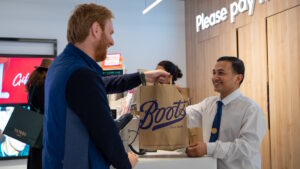By Elle Nadal, Director of Marketing, EMEA, at Iterable
Since 2014, digital shopping has been on an upward incline; in the last seven years, ecommerce shoppers increased from 1.32 billion to 2.14 billion in 2021. That means that nearly 30% of the global population shops online. Still nowhere close to reaching ecommerce critical mass, and with lockdowns and variants looming, there’s no doubt that 2022 will be a year of continued retail digitization.
Of course, the continued influx of ecommerce brands and businesses means that the online environment (which is already quite deluged) will continue to saturate. And it’s up to brands and businesses to orchestrate a way to stand out amongst a crowded digital bazaar.
The good news is that the question of reaching customers in a flooded market has a strategic answer, not a monetary one. Thanks to an increase in customer privacy concerns (by the people, and by political parties), third-party ad wars and massively spammy customer acquisition emails are soon to be a figment of the past, replaced by strategies that take customer psychology into consideration.
Here are some vital tips, based on Spotify’s sensational success, on how to attract more customers to online business by creating a more compelling, creative, and human ecommerce experience:
Personalised recommendations
We’re calling 2022 the year of customer experience, and rightfully so. The fact of the matter is that price and product are no longer competitive differentiators for consumers. Experience is. You could argue today, the role of the marketer has evolved — we are now dreamers, builders, and makers of customer experience. The foundation of a strong, memorable, and valuable customer experience? Personalisation. A great way to deploy personalisation? Recommendation.
Today, brands that provide offers and recommendations have been able to gain better traction with 91% of consumers. But on the same coin, the growing emphasis on privacy and security in 2021 highlights the importance of converting the collected information into value-added personalisation. With 90% of consumers willing to share personal behaviour data with companies, you can tailor the content to provide a better experience with your brand.
Brands with access to consumers have continuously been attempting to creatively leverage this data to improve the consumer experience. One well-known success story that hit the mark in delivering personalised content is Spotify.
With over 286 million active users, Spotify already provides personalised recommendations based on listeners’ habits and preferences. But the call from consumers for more emotional connection, and more personalisation, pushed the music streaming service to level up their recommendations. In early 2021, Spotify patented a technology that personalises content recommendations based on the “emotional state, gender, age, or accent” of the user. What was needed, the patent describes, is an “entirely different approach to collecting taste attributes of a user.”
Spotify 2.0 (as it’s colloquially known) indicates the way that brands should be looking at the evolution of personalisation. Consumer expectations of brands and businesses are rapidly accelerating and, with it, their perspective on personalisation. Brands need to stay close to the consumer conscience, and on the cutting age.
Keep Security and Privacy at the core
It’s important to note that, with great data access comes great data responsibility. It’s important to delve into an important prerequisite for success when it comes to personalisation: privacy. Iterable conducted a survey on 1,000 UK consumers in the holiday season, and found nearly a third of consumers citing transparency and trust as their preferred approach in promotion and advertisements. Similarly, the research highlighted the disinterest in transactional-based marketing, with a quarter of respondents citing straightforwardness as a major preference.
Spotify has won the trust of millions of customers around the world by being honest and transparent early on about collection and utilisation. This is where they set their mark. Each campaign deployed after trust is established leads to something all brands crave: improved customer relations.
Understanding user preferences is a great differentiator for brands in a competitive market. With growing data privacy regulations, first and zero-party data will become an ever more essential market tool. Trust and transparency stand at the forefront of this data collection, and acknowledging this can strengthen your consumer engagements and build user loyalty. On the other hand, keeping users uncertain and isolated will simply push them to find brands that provide the community experiences they seek.
Follow the lead of Spotify Wrapped
While data collection (and transparency) are the foundation of good CX, the deployment of this data is the realisation of experience. Spotify has had their consumers thoroughly engaged with personalisation far before the patent of 2.0; we saw immense success in their personalisation efforts after their 2020 #Wrapped campaign, which garnered the brand a cult following over 90 million users.
But why settle on laurels when you can optimise? Knowing the anticipation behind their #Wrapped release in 2021, Spotify added a unique and intuitive way to keep their customers engaged: community engagement.
Since the pandemic started, social interaction has been a luxury and (in many cases) a rarity. Consumers are yearning for an opportunity to find a silver lining in COVID-19 exiles and isolation. It’s why, these days, studies show that over 76% of consumers prefer shopping with brands they feel emotionally connected with. Like I said, emotion over price and product.
Spotify’s 2021 Wrapped campaign satisfies consumer Masloian needs for relationship and interaction by encouraging users to join group discussions about their yearly musical obsessions. It encourages them to connect. This community experience is enhanced through social media engagement; music was meant to be enjoyed together, and what better way to do this than a communal end of year celebration of it!
Spotify is an exemplar for all brands when it comes to building consumer experience and customer relationships. And your brand, regardless of the industry, can also benefit from tailoring user preferences in a similar way to provide personalised experiences.
Building consumer relations in 2022
As a marketer, the new year brings in a lot of concern – be it the pandemic, supply chain concerns or changes to data privacy. But much like Spotify, you can make use of authentic messaging to delight your customers and build a community.
As we continue the conversation with online shoppers, you can utilise the strategies of Spotify with your brands. Transparency on any disruptions, especially in these unpredictable times, can go a long way in helping you establish a healthy rapport with your customers and improve consumer relations long into 2022.












